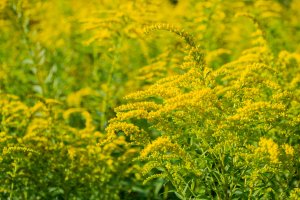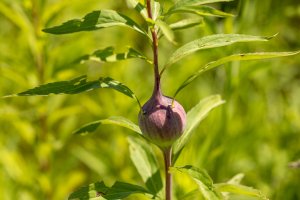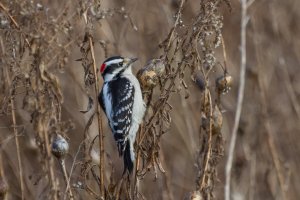Galls in Plants: Goldenrod Edition
August 23, 2023
By Steve Dishman, Interpreter

As summer draws to a close, you may notice the bright yellows of goldenrod flowers coming into bloom. Although some consider goldenrod a weed species, and others may not enjoy it because of allergies, many people around the world are appreciative of the many qualities of goldenrod, including its use in herbal teas and herbal medicine. The goldenrod is even the state flower of Kentucky and Nebraska. But, today, our focus is on the use of insects on goldenrod.
As a late-summer perennial, goldenrod species are important for pollinators like honeybees. But did you know that goldenrod is a host plant to nearly 100 species of moths and butterflies?
But there’s a special species of insect that uses goldenrod flowers in a particular way: The goldenrod gall fly (Eurosta solidaginis). A gall on a flower looks like an odd growth on the plant’s stem. So how does it work?

In the spring, adult goldenrod gall flies will mate on goldenrod and females will deposit the fertilized eggs into the buds of goldenrod. Adult flies only live for a matter of weeks and tend to walk across plants in search of mates, because they are poor fliers. The gall, although it looks like a tumor, is non-detrimental to the plant and it will still flower. The goldenrod gall fly larva will grow after a week or so and will forage down the bud of the plant. The gall that forms is the home of the larva, providing it shelter and food for the summer. The larva digs a tunnel usually in early fall to prepare for next spring, when it will need to leave the gall. It is imperative it does this, because adult goldenrod gall flies lack mouthparts and cannot tunnel. The larva goes through two stages and by its third stage, it is tolerant of the winter chill ahead and will spend winter in the gall. But how does the goldenrod gall fly survive in the frigid temperatures?
The goldenrod gall fly larvae that survive to the winter are in for the toughest test yet. Unlike vertebrate species that are ectotherms and adjust their internal temperature, the goldenrod gall fly produces sugars in its tissues. The sugars, in fact, lower the larvae’s fluid melting point, reducing the amount of ice that forms. Simply put, the larvae melt the ice that forms in the gall and convert the melted ice to usable sugars and proteins. The milder the winter, the more difficult it is for the resting larvae. Since they are ready to face freezing temperatures, warm temperatures can prove fatal to them. There is one more danger that sleeping goldenrod gall flies must contend with: predators.

Winter is a harsh season for birds, also. Woodpeckers and chickadees view goldenrod gall flies as a food source. Woodpeckers land onto the plant, pecking at the tunnel in the gall. Then, they can use their tongue to search for the wintering larvae. Chickadees lack the specialized bill and tongue that woodpeckers use, so they often just peck furiously at galls, opening it up to find their meal. Wasps, as well, will seek out galls for food in summer months. There are even anglers who will use the larvae as bait during ice fishing.
Goldenrod galls are fun to observe. The next time you pass a goldenrod plant, see if you can find any galls. You could find evidence of a bird looking for a snack, or the tunnel of a resting goldenrod gall fly larva, or if you’re lucky, adult flies using goldenrod to lay their eggs. We hope you enjoyed reading this blog post and look forward to seeing you again at your Huron-Clinton Metroparks!
